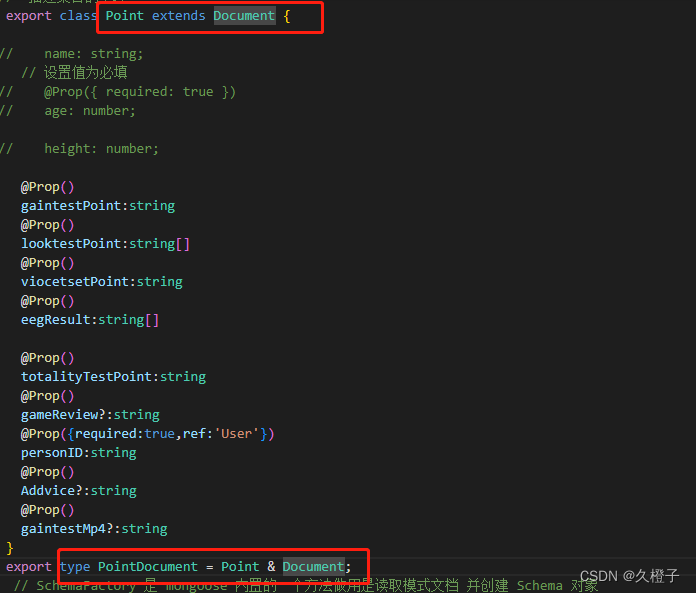nest js 英文官网 NestJS - A progressive Node.js framework
nestjs 中文网 NestJS 简介 | NestJS 中文文档 | NestJS 中文网
nestjs 中文网2 Nest.js 中文文档
以上是三个自学文档
连接mongodb
/* app.module.ts */
import { Module, Options } from '@nestjs/common';
import { AppController } from './app.controller';
import { AppService } from './app.service';
import { UserModule } from './user/user.module';
// 引入 Mongoose
import { MongooseModule } from '@nestjs/mongoose';
import { UploadModule } from './upload/upload.module';
@Module({
// 用 forRoot 方法连接数据库AddressBook
imports: [UserModule, MongooseModule.forRoot(), UploadModule],
controllers: [AppController],
providers: [AppService],
})
export class AppModule {}
nest g res user 快速生成一个模块

实体类文件夹entities是后来自己建的,注意,我们所有有和数据库有关的操作,包括新增文档的字段,都必须要在此显示的声明
point.entity.ts
// 实体类得分表
import { Prop, Schema, SchemaFactory } from '@nestjs/mongoose';
// @Prop 装饰器接受一个可选的参数,通过这个,你可以指示这个属性是否是必须的,是否需要默认值,或者是标记它作为一个常量,下面是例子
import { Document } from 'mongoose';
type Eegres={
mood:string
presure:string
relax:string
concentrate:string
tired:string
}
// 每个Schema对应MongoDB中的一个collection。
@Schema()
// 描述集合的字段
export class Point extends Document {
// name: string;
// 设置值为必填
// @Prop({ required: true })
// age: number;
// height: number;
@Prop()
gaintestPoint:string
@Prop()
looktestPoint:string[]
@Prop()
viocetsetPoint:string
@Prop()
eegResult:string[]
@Prop()
totalityTestPoint:string
@Prop()
gameReview?:string
@Prop({required:true,ref:'User'})
personID:string
@Prop()
Addvice?:string
@Prop()
gaintestMp4?:string
}
export type PointDocument = Point & Document;
// SchemaFactory 是 mongoose 内置的一个方法做用是读取模式文档 并创建 Schema 对象
export const PointSchema = SchemaFactory.createForClass(Point);
/**
* @name
* 原始 Schema 定义也可以被传递给装饰器。这也非常有用,举个例子,一个属性体现为一个嵌套对象而不是一个定义的类。要使用这个,需要从像下面一样从 @nestjs/mongoose 包导入 raw()
* @Prop(raw({
firstName: { type: String },
lastName: { type: String }
}))
details: Record<string, any>;
* https://docs.nestjs.cn/9/techniques?id=mongo
*/
ref:'User'是关联User这个集合,后面会讲
user.entity.ts
// export class User {}
/* user.schema.ts 数据库字段映射,相当于实体类*/
import { Prop, Schema, SchemaFactory } from '@nestjs/mongoose';
// @Prop 装饰器接受一个可选的参数,通过这个,你可以指示这个属性是否是必须的,是否需要默认值,或者是标记它作为一个常量,下面是例子
import { Document } from 'mongoose';
// 每个Schema对应MongoDB中的一个collection。
@Schema()
// 描述集合的字段
export class User extends Document {
// name: string;
// 设置值为必填
// @Prop({ required: true })
// age: number;
// height: number;
@Prop()
age:string
@Prop()
identifier:string
@Prop()
name:string
@Prop()
nation:string
@Prop()
grade:string
@Prop()
schemeNum:string
@Prop()
organ:string
@Prop()
sex:number
}
export type UserDocument = User & Document;
// SchemaFactory 是 mongoose 内置的一个方法做用是读取模式文档 并创建 Schema 对象
export const UserSchema = SchemaFactory.createForClass(User);
以下是一个crud模板
user.controller.ts
/* user.controller.ts */
// 引入 Nest.js 内置的各个功能
import { Body, Controller, Delete, Get, Param, Post, Put, Query } from '@nestjs/common';
// 引入用户服务
import { UserService } from './user.service';
// 引入创建用户 DTO 用于限制从接口处传来的参数
import { CreatePointDto,createPerson } from './dto/create-user.dto';
// 配置局部路由
@Controller('user')
export class UserController {
constructor(private readonly userService: UserService) { }
@Get('getpoints')
async getPoints(@Query() query){
return await this.userService.getPoint(query.sid)
}
// 创建得分表
@Post('createpoint')
async createPoint(@Body() body: CreatePointDto) {
return this.userService.create(body);
}
// // 创建得分表
// @Post('createUser')
// async createUser(@Body() body: CreatePointDto) {
// return this.userService.create(body);
// }
// 添加用户
@Post('addUsers')
async addUsers(@Body() body:createPerson){
return this.userService.addPerson(body)
}
// 根据名字查找用户
@Get('findUserName')
async findUserName(@Query ( ) query:{name:string}){
return this.userService.findname(query.name)
}
//查找所有 user 路由
@Get('findAll')
async findAll() {
console.log('查找所有 user ');
console.log(this.userService.findAll);
return this.userService.findAll();
}
// 查找某一个用户路由
@Get('findOne')
async findOne(@Query() query: any) {
// 从前端传来的参数中解出personID
console.log(query.personID);
return await this.userService.findOne(query.personID);
}
// 删除一个用户的路由
@Delete(':sid')
deleteUser(@Param() param: any) {
console.log('dsdsdsd');
return this.userService.delete(param.sid);
}
// 更改用户信息的路由
@Put(':sid')
updateUser(@Body() body: any, @Param() param: any) {
return this.userService.updateUser(param.sid, body);
}
}
user.module.ts
/* user.module.ts */
import { MiddlewareConsumer, Module ,NestModule, RequestMethod } from '@nestjs/common';
import { UserController } from './user.controller';
import { UserService } from './user.service';
import { MongooseModule } from '@nestjs/mongoose';
import { UserSchema ,User} from './entities/user.entity';
import {Point,PointSchema } from './entities/point.entity'
import {LoggerMiddleware} from "src/logger/logger.middleware"
@Module({
// MongooseModule提供了forFeature()方法来配置模块,即用来关联数据库实体类,包括定义哪些模型应该注册在当前范围中。
// 如果你还想在另外的模块中使用这个模型,将MongooseModule添加到CatsModule的exports部分并在其他模块中导入CatsModule。
// 这里的 name:'Users' 为集合名称,与 service 中注入的表名称对应两者不一样会报错
imports: [MongooseModule.forFeature([
{ name: User.name, schema: UserSchema, collection: 'Users' },
{ name: Point.name, schema: PointSchema, collection: 'point' }
]),
],
controllers: [UserController],
providers: [UserService],
})
// 不知道怎么实现就查询它的类型
export class UserModule implements NestModule {
// 接收一个消费者,调用apply方法来注册这个中间件并指定要作用的路由
configure(consumer: MiddlewareConsumer) {
// 三种写法,局部注册中间件
// consumer.apply(LoggerMiddleware).forRoutes('user')
// consumer.apply(LoggerMiddleware).forRoutes({path:'user',method:RequestMethod.GET})
consumer.apply(LoggerMiddleware).forRoutes(UserController)
}
}
user.service.ts
import { Model } from 'mongoose';
import { InjectModel } from '@nestjs/mongoose';
// import { User, UserDocument } from 'src/blog/schemas/blog.schemas';
import { User, UserDocument } from 'src/user/entities/user.entity';
import { Point, PointDocument } from './entities/point.entity'
import { CreatePointDto,createPerson } from './dto/create-user.dto';
import { Injectable } from '@nestjs/common';
import { lookupService } from 'dns';
@Injectable()
export class UserService {
// 注册Schema后,可以使用 @InjectModel() 装饰器将 User 模型注入到 UserService 中:
// 这里的'Users'需要和user.module定义的数据库表名对上
constructor(
@InjectModel(User.name) private userTest: Model<UserDocument>,
@InjectModel(Point.name) private pointTest: Model<Point>
) { }
// 查找全部的得分表1
async getPoint(parmas): Promise<any> {
if (!!parmas === false) {
// 查询全部 根据参数判断1
return await this.pointTest.find({}).populate('personID').exec()
}
else {
return await this.pointTest.find({ personID: parmas }).populate('personID').exec()
}
}
// 查找得分表
async getPointonly(personID: string): Promise<any> {
const temp = await this.pointTest.find({ _id: personID }).populate('personID').exec();
return temp;
}
// 添加得分表
async create(createUserDto: CreatePointDto): Promise<Point> {
console.log(createUserDto);
const createUser = new this.pointTest(createUserDto);
const temp = await createUser.save();
return temp;
}
//添加用户
async addPerson(createPerson:createPerson){
console.log(createPerson);
const createUser = new this.userTest(createPerson);
const temp = await createUser.save();
return temp;
}
// 通过名字查找用户
async findname(name:string){
console.log(name);
const data = await this.userTest.find({
name:name
})
return data
}
// 查找所有用户
async findAll(): Promise<User[]> {
// 这里是异步的
const temp = await this.userTest.find().exec();
console.log(__dirname);
return temp;
}
// 查找
async findOne(personID: string): Promise<User[]> {
// 这里是异步的
// console.log(personID);
const temp = await this.userTest.find({ _id: personID },).exec();
return temp;
}
// 删除
async delete(sid: number) {
// 这里是异步的 remove 方法删除成功并返回相应的个数
const temp = await this.userTest.deleteOne({ _id: sid });
return temp;
}
// 修改
async updateUser(sid: string, data: any) {
// 这里是异步的
const temp = await this.userTest.updateOne({ _id: sid }, { $set: data });
return temp;
}
}
这里有个问题

这里会明确这两个变量的类型,
类型分别为

ts 中类也可以作为接口被传入泛型,与interface的功能一致,这里其实我是学习网上的写法,网上的写法是Model<UserDocument>我的写法则是Model<User>
就类型来说Point与PointDocument应该是等价的
事实上ide推导的类型两者完全一致